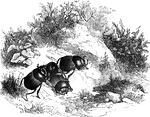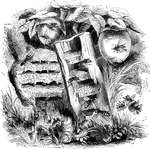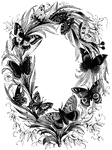
Scarab Beetle
"The S. nasicornis is a European species, common in gardens, and is noted for a pair of curious…

Click Beetle
"The Elater striatus of Caenne, is an inch long, of a black color, and striped upon the back."…

Giant Buprestis
"The Giant Buprestis, B. gigantea of guiana, is two inches long, and its body is of a green…

Deathwatch Beetles
"Other species, which also bore into timber in their larva state, are well known by the name of Death-watch…
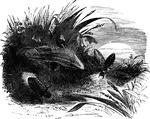
Glowworm
"The female is chiefly luminous. It is a flat, grayish-brown creature, rather more than half an inch…
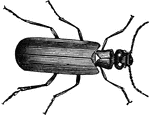
Spanish Fly
"These insects are common in the South of Europe, and are especially abundant in Spain, where they are…
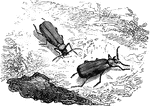
Cardinal Beetle
"One of the most beautiful of the European species of trachelia is the Pyrochroa rubens, which…

Churchyard Beetle
"These insects are generally found in dark and dirty places about houses, in cellars, and similar situations."…

Mealworm
"Tenebrio Molitor. Commonly known as the mealworm or the mealworm beetle. Common in Europe and in this…
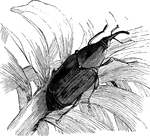
Palm Weevil
"Found in South Ameica, is a very large species, nearly two inches long; it is black, and lives on the…
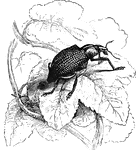
Diamond Beetle
"Even among the small species several of great beauty are to be met with, and few insects can boast…
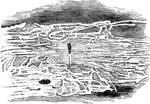
Typograhic Beetle
"The typographic beetle recieves it's name... from the circumstance that the burrows formed by it in…
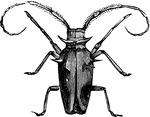
Capricorn Beetle
"The insects of this tribe, called Capricorn Beetles and distributed throughout most parts…

Blackspotted Pliers Support Beetle
"The Leptura Mordax, or Rhagium Mordax of Europe, three-fourths of an inch long,…
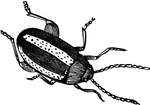
Turnip Fly
The European Turnip-Fly, Haltica nemorum, one of the most destructive species, belongs to a…

Leaf Beetle
"The Popular-tree Golden bug, chrysomela populi, of a blueish-green, has a strong odor, and…

Cassida gibbosa
"The Cassida gibbosa of Brazil, three quarters of an inch long, is one of the larger species…
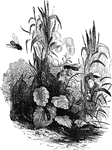
Honey Bee
"They are said to have originated in Greece, but have since spread all over the world; they live in…
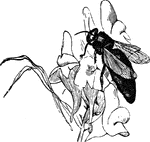
Queen Bee
"The queen bee is larger and longer than the other bees; she moves in a slow and majestic manner, and…
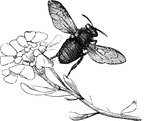
Drone Bee
"The working bee, for collecting wax, enters a flower, the stamens of which are loaded with pollen.…

Working Bees
""The working bee, for collecting wax, enters a flower, the stamens of which are loaded with pollen.…
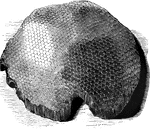
honey-comb
"The comb is made of wax, found in various plants, but which is also secreted by the bees themselves…
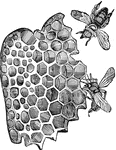
Cells of Honey Bees
"The hexagonal cells for the honey are build upon precisely that mathematical angle which affords the…
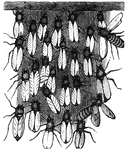
Bees Secreting Wax
"The secretion of wax, it would appear, goes on best when the bees are in a state of repose, and the…
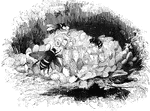
Interior of the Humble-Bee's Nest
"The Humble-bees, or as they are often called in this country, the Bumble-bees are…

Nest of the Carder Bee
"The elevation of the dome, which is all built from the interior, is from four to six inches above the…

Mason Bee
"The Mason Bee, Osmia, of which there are many kinds, makes its cells in spaces from which…

Carpenter Bee
"A, B, C, tunnelings of the carpenter bee; E, the carpenter bee; D, a partition; F, teeth, magnified"…

Hornets and Nest
"The Hornets resemble the Wasps in their habits, but but they are noted for their spitefulness and the…

Aardvark
"Aard-vark is a burrowing insect-eating animal of the order Edentata found in South Africa. The name…
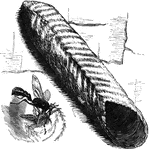
Dauber
"A South American genus, Pelopaeus, allied to the preceeding, is called the Dauber, from its…

Ants and Their Structures
"This tribe, which includes the various kinds of Ants, is composed entirely of insects which live in…
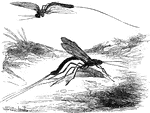
Ichneumon
"The ichineumons, with long ovipositors, as the European species, Ichneumon manifestator, seek…
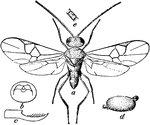
Apanteles aletiæ
"Apanteles aletiæ, much enlarged. ITs species infest various lepidpterous larvæ, and form…
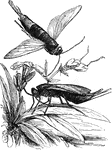
Sawfly
"On the continent of Europe the Sirex gigas often appears in immense numbers, and does great…
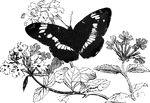
Sybil Butterfly
"The Sybil Butterfly, P. Sybilla, sometimes called the Mourning Butterfly, is a common…
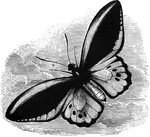
Priam Butterfly
"The Priam butterfly, Papilio priamus, is a native of the Eastern Archipelago; its wings are…
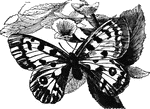
Apollo Butterfly
"The Apollo butterfly, P. Apollo, is found in the damp meadows of the high Alps; the wings…
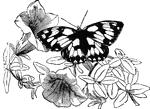
Half-Mourning Butterfly
"The Galatea Butterfly, P. Galatea, A Euoprean species, called The Half-Mourning Butterfly,…
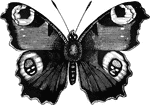
Peacock Butterfly
"The Peacock-butterfly, V. Io, has the edges of the wings denticulated; above they are of a…
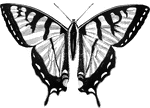
Troilus Butterfly
"The Troilus Butterfly, Papilio Troilus, is a superb insect, the wings denticulated, black,…

Death's Head Moth
"The most remarkable species is the Death's Head Moth, Acherontia Atropos, a large kind,…
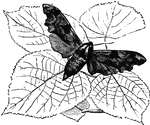
Lime-tree sphinx
"The Lime-tree sphinx, Sphinx tiliae, has the wings denticulated and angular; it is nocturnal,…
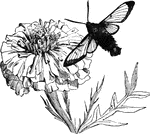
Hummingbird Moth
"A considerable number of insects belonging to Sphingina have transparents wings. Among them is the…
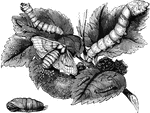
Silkworm Moth, Caterpillar, and Chrysalis
"This important insect is a native of the north of China; and a great portion of the supplies of silk…

Chrysalis of the Luna Moth
"Among the larger and more splendid moths of our own country is the Luna Moth, or Green Emperor Moth,…
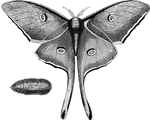
Luna Moth
"Among the larger and more splendid moths of our own country is the Luna Moth, or Green Emperor Moth,…

Caterpillar of the Luna Moth
"Among the larger and more splendid moths of our own country is the Luna Moth, or Green Emperor Moth,…

Cecropia Moth
"The Cecropia Moth, A. Cecropia, is of a dusky reddish-brown; the wings expand six inches,…

Processionary Caterpillars
"If the guide stops a moment all the followers halt; if he continues the route, they all hasten after…

